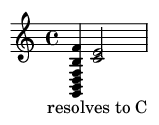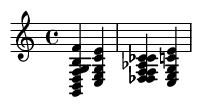The Tritone: A Musician's Guide to the Devil's Interval
The tritone, an interval spanning six semitones, is arguably the most fascinating and historically significant interval in Western music. Known for its jarring dissonance and powerful need for resolution, its story charts a course from being a compositional problem in the Middle Ages to an essential expressive tool in blues, jazz, and modern film scores. Its infamous nickname, diabolus in musica (the devil in music), hints at a storied past, but its true power lies in its unique acoustic properties and versatile harmonic functions.
This guide will demystify the tritone, exploring its structure, history, and applications. Whether you're a composer, performer, or curious listener, understanding the tritone is key to unlocking a deeper appreciation of musical tension and release.
What is a Tritone? Structure and Measurement
A tritone is an interval defined by its precise distance. In the twelve-tone system, it is unique because it divides the octave into two equal halves.
- Distance: 6 semitones (or half steps)
- Whole Tone Count: 3 whole tones (hence "tri-tone")
- Cents: 600 cents (an octave is 1200 cents)
- Symmetry: A tritone is its own inversion. For example, the interval from C up to F# is a tritone, and the interval from F# up to the next C is also a tritone.
The tritone can be spelled in two primary ways, each with its own name and typical harmonic function:
Augmented Fourth (A4): An interval of a fourth raised by a half step (e.g., C to F#).
Diminished Fifth (d5): An interval of a fifth lowered by a half step (e.g., C to Gb).
While C-F# and C-Gb sound identical on a piano (enharmonically equivalent), their musical spelling dictates how they function and resolve within a piece of music.
Hearing the Tritone: Musical Examples
Example 1: The Basic Interval
Listen to the dissonant quality of the tritone (C to F#) when its notes are played first sequentially, then together as a chord.

Example 2: In a Dominant Seventh Chord
The tritone is the defining sound of the dominant seventh chord. In a G7 chord (G-B-D-F) , the interval between the third (B) and the seventh (F) is a tritone.
Example 3: In the Blues Scale
The tritone is essential to the sound of the blues. The "blue note" is a flattened fifth, which forms a tritone with the root of the scale. Here is a C Blues Scale (C-Eb-F-Gb-G-Bb) with the C-Gb tritone highlighted.
A "Devilish" History: Myth vs. Reality
The tritone's nickname, diabolus in musica, has led to a popular myth that the interval was banned by the Church for its supposed satanic qualities. The historical reality is more practical and less sensational.
- A Practical Problem: In early medieval music, which was dominated by pure-sounding intervals like perfect fourths and fifths, the tritone was considered the most dissonant interval. Theorists like Guido of Arezzo singled it out as unstable and difficult for choirs to sing accurately. The term diabolus in musica was a vivid way to warn students of its compositional difficulty.
- Rules of Counterpoint: It was not "banned" but rather avoided or handled with extreme care according to the strict rules of counterpoint. The goal was smooth, consonant voice leading suitable for sacred music, and the tritone disrupted that ideal.
- Gradual Acceptance: By the late Renaissance and Baroque periods, composers learned to control the tritone's instability. They discovered its power to create harmonic tension that could be beautifully resolved, making it a cornerstone of the dominant-tonic relationship that would define Western harmony for centuries.
- Modern Romanticization: The "satanic" association is largely a modern romanticization, amplified by its use in film scores and heavy metal music to create a sense of darkness or evil.
The Harmonic Function of the Tritone
The tritone's instability is not a flaw; it's its greatest strength. This tension creates a powerful desire for resolution, driving music forward.
Driving Force of the Dominant Chord
The most important function of the tritone is within the dominant seventh (V7) chord. In the key of C Major, the V7 chord is G7 (G-B-D-F). The tritone occurs between the leading tone (B) and the fourth scale degree (F). These two notes are inherently unstable and pull strongly toward the tonic chord:
- The leading tone B wants to resolve up by a half step to the tonic, C.
- The fourth degree F wants to resolve down by a half step to the third of the tonic, E.
This inward resolution of the tritone (B-F to C-E) is the fundamental engine of tonal harmony, creating the satisfying feeling of "coming home" when a V7 chord resolves to a I chord.
Tritone Resolution in a V7-I Cadence

Diminished and Half-Diminished Chords
Tritones are also the building blocks of diminished and half-diminished chords. A diminished triad (e.g., B-D-F) is built from a minor third and a diminished fifth (a tritone). A fully diminished seventh chord (e.g., B-D-F-Ab) is a stack of minor thirds containing two interlocking tritones (B-F and D-Ab), making it one of the most dissonant and versatile chords in tonal music.
The Tritone in Jazz and Blues
The Soul of the Blues
In the blues, the tritone isn't just a point of tension to be resolved; it's an expressive color in its own right. The "blue note" (a flattened 5th) creates a tritone against the root, and this clash is fundamental to the "bluesy" sound. Musicians often bend or slide into this note, lingering on the dissonance to create a feeling of soulfulness and struggle.
Tritone Substitution in Jazz
Jazz harmony takes the tritone's function to a new level with a technique called tritone substitution. This involves replacing a dominant 7th chord with another dominant 7th chord whose root is a tritone away.
For example, in the key of C, the standard V7 chord is G7. A jazz musician might substitute it with Db7. Why does this work? Because they share the exact same tritone:
- G7 has the tritone B–F.
- Db7 (Db-F-Ab-Cb) has the tritone F–Cb (Cb is enharmonically the same as B).
Since both chords contain the same tension notes, they can serve the same function of resolving to the C major tonic, but the Db7 adds a different chromatic flavor to the bass line (Db moving to C).
Example: Tritone Substitution (G7 vs Db7 to C)

Famous Musical Examples
Once you know what to listen for, you'll hear the tritone everywhere:
- "The Simpsons Theme" by Danny Elfman: The very first two notes of the vocal melody ("The Simp-") are a prominent ascending tritone.
- "Maria" from West Side Story: Leonard Bernstein uses an ascending tritone on the opening cry of "Ma-ri-a" to convey yearning and tension.
- "Black Sabbath" by Black Sabbath: The main riff is built on a slow, menacing tritone, forever linking the interval with heavy metal.
- "Purple Haze" by Jimi Hendrix: The intro features a jarring tritone played by the guitar and bass.
- Classical Music: Composers from Bach to Stravinsky used the tritone for dramatic effect. Saint-Saëns's Danse Macabre uses a tritone in the violin part to represent the devil tuning his fiddle.
Theoretical Deep Dive: A4 vs. d5 Resolution
As mentioned, the spelling of a tritone—Augmented Fourth vs. Diminished Fifth—signals its likely resolution. While not a strict rule, this tendency is a core principle of voice leading.
- An Augmented Fourth (A4) typically resolves outward to a sixth.
- A Diminished Fifth (d5) typically resolves inward to a third.
Example: Resolution Tendencies

Practice and Recognition
Training your ear to recognize the tritone is a vital skill for any musician. Use reference songs like "Maria" or "The Simpsons Theme" to internalize its sound. Practice singing and playing the interval and its resolutions.
Ear Training Exercise
Practice identifying these ascending tritones.

Conclusion: Music's Powerful Angel
The tritone's journey from a problematic dissonance to an indispensable tool mirrors the evolution of Western music itself. It teaches us that the concepts of "dissonance" and "consonance" are not absolute but depend on context, style, and our collective ear. By creating tension, the tritone makes resolution possible, giving music its emotional drive and narrative arc.
Far from a "devilish" interval to be feared, the tritone is a powerful force for expression. Understanding its properties and functions is essential for any serious musician. Once you embrace its instability, you'll find that the diabolus in musica has become one of music's most powerful and versatile angels.
References:
Aldwell, E., Schachter, C., & Cadwallader, A. (2018) . Harmony and Voice Leading (5th ed.). Cengage Learning.
Levine, M. (2011). The Jazz Theory Book. O'Reilly Media.
Taruskin, R. (2005). Music from the Earliest Notations to the Sixteenth Century. Oxford University Press.
Kostka, S., & Payne, D. (2018). Tonal Harmony: With an Introduction to Post-Tonal Music (8th ed.). McGraw-Hill Education.
